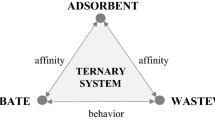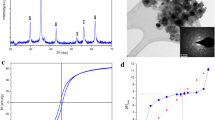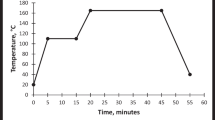Abstract
Arsenic contamination of groundwater is a major threat to human beings globally. Among various methods available for arsenic removal, adsorption is fast, inexpensive, selective, accurate, reproducible and eco-friendly in nature. The present paper describes removal of arsenate from water on zirconium oxide-coated sand (novel adsorbent). In the present work, zirconium oxide-coated sand was prepared and characterised by infrared and X-ray diffraction techniques. Batch experiments were performed to optimise different adsorption parameters such as initial arsenate concentration (100–1,000 μg/L), dose (1–8 g/L), pH of the solution (2–14), contact time (15–150 min.), and temperature (20, 30, 35 and 40 °C). The experimental data were analysed by Langmuir, Freundlich, Temkin and Dubinin–Radushkevich isotherm models. Furthermore, thermodynamic and kinetic parameters were evaluated to know the mode of adsorption between ZrOCMS and As(V). The maximum removal of arsenic, 97 %, was achieved at initial arsenic concentration of 200 μg/L, after 75 min at dosage of 5.0 g/L, pH 7.0 and 27 ± 2 °C. For 600 μg/L concentration, the maximum Langmuir monolayer adsorption capacity was found to be 270 μg/g at 35 °C. Kinetic modelling data indicated that adsorption process followed pseudo-second-order kinetics. The mechanism is controlled by liquid film diffusion model. Thermodynamic parameter, ΔH°, was −57.782, while the values of ΔG° were −9.460, −12.183, −13.343 and −13.905 kJ/mol at 20, 30, 35 and 40 °C, respectively, suggesting exothermic and spontaneous nature of the process. The change in entropy, ΔS° = −0.23 kJ/mol indicated that the entropy decreased due to adsorption of arsenate ion onto the solid adsorbent. The results indicated that the reported zirconium oxide-coated marine sand (ZrOCMS) was good adsorbent with 97 % removal capacity at 200 μg/L concentration. It is interesting to note that the permissible limit of arsenic as per World Health Organization is 10 μg/L, and in real situation, this low concentration can be achieved through this adsorbent. Besides, the adsorption capacity showed that this adsorbent may be used for the removal of arsenic from any natural water resource.










Similar content being viewed by others
References
Adamson AW, Gast AP (1997) Physical chemistry of surfaces, 6th edn. Wiley-Interscience, New York
Ali I (2010) The quest for active carbon adsorbent substitutes: inexpensive adsorbents for toxic metal ions removal from wastewater. Sep Purif Rev 39:95–171
Ali I (2012) New generation adsorbents for water treatment. Chem Rev 112:5073–5091
Ali I, Asim M, Khan TA (2012) Low cost adsorbents for removal of organic pollutants from waste water. J Environ Manag 113:170–183
Ali I, Gupta VK (2006) Advances in water treatment by adsorption technology. Nature Protocol 1:2661–2667
Ali I, Khan TA, Asim M (2011) Removal of arsenic from water by electro-coagulation and electro-dialysis techniques. Sep Purif Rev 40:25–42
Allen SJ, Mckay G, Porter JF (2004) Adsorption isotherm models for basic dye adsorption by peat in single and binary component systems. J Colloid Interface Sci 280:322–333
Allen SJ, Whitten LJ, Murray M, Duggan O (1997) The adsorption of pollutants by peat, lignite and activated chars. J Chem Tech Biotechnol 68:442–452
Anbalagan G, Prabakaran AR, Gunasekaran S (2010) Spectroscopic characterization of Indian standard sand. J Applied Spectroscopy 77:86–94
Anderson MA, Ferguson JF, Gravis J (1976) Arsenate adsorption on aluminium hydroxide. J Colloid Interface Sci 54:391–399
Baskan MB, Pala A (2010) A statistical experiment design approach for arsenic removal by coagulation process using aluminium sulphate. Desalination 254:42–48
Bhattacharyya KG, Sharma A (2005) Kinetics and thermodynamics of methylene blue adsorption on neem leaf powder. Dyes Pigments 65:51–59
Boyd GE, Adamson AW, Myers LS (1947) The exchange adsorption of ions from aqueous solutions by organic zeolites. II: kinetics. J Am Chem Soc 69:2836–2848
Chen R, Zhang Z, Yang Y, Lei Z, Chen N, Guo X, Zhao C, Sugiur N (2011) Use of ferric-impregnated volcanic ash for arsenate (V) adsorption from contaminated water with various mineralization degrees. J Colloid Interface Sci 353:542–548
Cheung CW, Porter JF, McKay G (2001) Sorption kinetic analysis for the removal of cadmium ions from effluents using bone char. Water Res 35(3):605–612
Chien SH, Clayton WR (1980) Application of Elovich equation to the kinetics of phosphate release and sorption in soils. Soil Sci Soc Am J 44:265–268
Choong TSY, Chuah TG, Robiah Y, Koay FLG, Azni I (2007) Arsenic toxicity, health hazards and removal techniques from water: an overview. Desalination 217:139–166
Daus B, Wennrich R, Weiss H (2004) Sorption materials for arsenic removal from water: a comparative study. Water Res 38:2948–2954
Dixit S, Hering JG (2003) Comparison of arsenic(V) and arsenic(III) sorption onto iron oxide minerals: implications for arsenic mobility. Environ Sci Technol 37:4182–4189
Dubinin MM (1960) The potential theory of adsorption of gases and vapors for adsorbents with energetically non-uniform surface. Chem Rev 60:235–266
Dubinin MM, Zaverina ED, Radushkevich LV (1947) Sorption and structure of active carbons. I. Adsorption of organic vapors. Zh Fiz Khim 21:1351–1362
El-Ashtoukhy E-SZ, Amin NK, Abdelwahab O (2008) Removal of lead(II) and copper(II) from aqueous solution using pomegranate peel as a new adsorbent. Desalination 223:162–173
Foo KY, Hameed BH (2010) Review: insights into the modeling of adsorption isotherm systems. Chem Eng J 156:2–10
Freundlich HMF (1906) Over the adsorption in solution. J Phys Chem 57:385–471
Goswami S, Ghosh UC (2005) Studies on adsorption behaviour of Cr (VI) onto synthetic hydrous stannic oxide. Water SA 31:57–602
Graeme KA, Pollack CV Jr (1998) Heavy metal toxicity. Part I: arsenic and mercury. J Emerg Med 16:4556
Gulledge JH, O’Conor JT (1973) Removal of arsenic (V) from water by adsorption on aluminium and ferric hydroxide. J Am Water Works Assoc 65:548–553
Gupta VK, Mittal A, Krishnan L, Mittal J (2006) Adsorption treatment and recovery of the hazardous dye, Brilliant blue FCF, over bottom ash and de-oiled soya. J Colloid Interface Sci 293:16–26
Gupta VK, Jain R, Varshney S (2007a) Electrochemical removal of the hazardous dye Reactofix Red 3 BFN from industrial effluents. J Colloid Interface Sci 312:292–296
Gupta VK, Jain R, Mittal A, Mathur M, Sikarwar S (2007b) Photochemical degradation of the hazardous dye Safranin-T using TiO2 catalyst. J Colloid Interface Sci 309:464–469
Gupta VK, Rastogi A, Nayak A (2010a) Adsorption studies on the removal of hexavalent chromium from aqueous solution using a low cost fertilizer industry waste material. J Colloid Interface Sci 342:135–141
Gupta VK, Rastogi A, Nayak A (2010b) Biosorption of nickel onto treated alga (Oedogonium hatei): application of isotherm and kinetic models. J Colloid Interface Sci 342:533–539
Gupta VK, Gupta B, Rastogi A, Agarwal S, Nayak A (2011) A comparative investigation on adsorption performances of mesoporous activated carbon prepared from waste rubber tire and activated carbon for a hazardous azo dye-Acid Blue113. J Hazard Mater 186:891–901
Gupta VK, Ali I, Saleh TA, Nayak A, Agarwal S (2012) Chemical treatment technologies for waste-water recycling—an overview. RSC Advances 2:6380–6388
Hall KR, Eagleton LC, Acrivos A, Vermeulen T (1966) Pore and solid-diffusion kinetics in fixed-bed adsorption under constant-pattern conditions. Ind Eng Chem Fund 5:212–223
Hang C, Li Q, Gao S, Shang JK (2012) As(III) and As(V) Adsorption by hydrous zirconium oxide nanoparticles synthesized by a hydrothermal process followed with heat treatment. Ind Eng Chem Res 51:353–361
Hege KV, Verhaege M, Verstraete W (2004) Electro-oxidative abatement of low-salinity reverse osmosis membrane concentrates. Water Res 38:1550–1558
Ho YS (2004) Citation review of Lagergren kinetic rate equation on adsorption reaction. Scientometrics 59:171–177
Ho YS, McKay G (1998) The Kinetics of sorption of basic dyes from aqueous solution by sphagnum moss peat. Can J Chem Eng 76:822–7
Hobson JP (1969) Physical adsorption isotherms extending from ultra high vacuum to vapor pressure. J Phys Chem 73:2720–2727
Hristovski KD, Westerhoff PK, Crittenden JC, Olson LW (2008) Arsenate removal by nanostructured ZrO2 spheres. Environ Sci Technol 42:3786–3790
Hsia TH, Lo SL, Lin CF, Lee DY (1994) Characterization of arsenate adsorption on hydrous iron oxide using chemical and physical methods. Colloid Surf A: Physicochem Eng Aspects 85:1–7
Jain CK, Ali I (2000) Arsenic: occurrence, toxicity and speciation techniques. Water Res 34:4304–4312
Jay JA, Blute NK, Hemond HF, Durant JL (2004) Arsenic-sulfides confound anion exchange resin speciation of aqueous arsenic. Water Res 38:1155–1158
Jeong Y, Fan M, Singh S, Chuang CL, Saha B, Leeuwen JHV (2007) Evaluation of iron oxide and aluminum oxide as potential arsenic(V) adsorbents. Chem Eng and Process: Process Intens 46:1030–1039
Johnson DL (1971) Simultaneous determination of arsenate and phosphate in natural waters. Environ Sci Technol 5:411–414
Johnson DL, Pilson MEQ (1972) Spectrophotometric determination of arsenite, arsenate and phosphate in natural waters. Anal Chim Acta 58:289–299
Kalavathy MH, Karthikeyan T, Rajgopal S, Miranda LM (2005) Kinetic and isotherm studies of Cu(II) adsorption onto H3PO4-activated rubber wood sawdust. J Colloid Interface Sci 292:354–362
Kanel SR, Manning B, Charlet L, Choi H (2005) Removal of arsenic(III) from groundwater by nanoscale zero-valent iron. Environ Sci Technol 39:1291–1298
Kannan K, Sundaram MM (2001) Kinetics and mechanism of removal of methylene blue by adsorption on various carbons—a comparative study. Dyes Pigments 51:25–40
Karim MM (2000) Arsenic in ground water and health problems in Bangladesh. Water Res 34:304–310
Karthikeyan S, Gupta VK, Boopathy R, Titus A, Sekaran G (2012) A new approach for the degradation of high concentration of aromatic amine by heterocatalytic Fenton oxidation: kinetic and spectroscopic studies. J Molecular Liquids 173:153–163
Kim J, Benjamin MM (2004) Modeling a novel ion exchange process for arsenic and nitrate removal. Water Res 38:2053–2062
Kim Y, Kim C, Choi I, Rengraj S, Yi J (2004) Arsenic removal using mesoporous alumina prepared via a templating method. Environ Sci Technol 38:924–931
Kundu S, Gupta AK (2007) Adsorption characteristics of As (III) from aqueous solution on iron oxide coated cement (IOCC). J Hazard Mater 142:247–254
Kuriakose S, Singh TS, Pant KK (2004) Adsorption of arsenic (III) from aqueous solution onto iron oxide impregnated activated alumina. Water Qual Res J Canada 39:260–268
Lagergren S (1898) About the theory of so-called adsorption of soluble substances. Kungliga Svenska Vetenskapsakademiens Handlingar 24(4):1–39
Langmuir I (1918) The adsorption of gases on plane surfaces of glass, mica, and platinum. J Am Chem Soc 40:1361–1403
Low MJD (1960) Kinetics of chemisorptions of gases on solids. Chem Rev 60:267–312
Mall ID, Srivastava VC, Agarwal NK, Mishra IM (2005) Removal of Congo red from aqueous solution by bagasse fly ash and activated carbon: kinetic study and equilibrium isotherm analyses. Chemosphere 61:492–501
Manivannan R, Daniel A, Srikanth I, Kumar A, Sarkar R, Ghoshal P, Devi R (2010) Thermal stability of zirconia-coated multiwalled carbon nanotubes. Defence Sci J 60:337–342
Manna B, Dasgupta M, Ghosh UC (2004) Crystalline hydrous titanium oxide (CHTO)—an arsenic (III) scavenger from natural water. J Water SRT-Aqua 53:483–495
Manna BR, Dey S, Debnath S, Ghosh UC (2003) Removal of arsenic from groundwater using crystalline hydrous ferric oxide (CHFO). Water Qual Res J Can 38:193–210
Manning BA, Fendorf SE, Goldberg S (1998) Surface structures and stability of arsenic (III) on goethite: spectroscopic evidence for inner-sphere complexes. Environ Sci Technol 32:2383–2388
Marathe RB (2012) XRD and SEM analysis of Tapti river sediment: a case study. Arch Appl Sci Res 4:78–84
Meharg AA, Rahman MM (2003) Arsenic contamination of Bangladesh paddy field soils: implications for rice contribution to arsenic consumption. Environ Sci Technol 37:229–234
Mittal A, Gupta VK, Malviya A, Mittal J (2008) Process development for the batch and bulk removal and recovery of a hazardous, water-soluble azo dye (Metanil Yellow) by adsorption over waste materials (Bottom Ash and De-Oiled Soya). J Hazard Mater 151:821–832
Moenke HHW (1974) Silica, the three-dimensional silicates, borosilicates and beryllium silicates. The infrared spectra of minerals. EdVC Farmer Mineralogical Society, London
Murphy J, Riley JP (1962) A modified single solution method for the determination of phosphate in natural waters. Anal Chim Acta 27:31–36
Nadeem M, Mahmood A, Shahid SA, Shah SS, Khalid AM, McKAY G (2006) Sorption of lead from aqueous solution by chemically modified carbon adsorbent. J Hazard Mater 138:604–613
Nayak PS, Singh BK (2007) Instrumental characterization of clay by XRF, XRD and FTIR. Bull Mater Sci 30:235–238
Nriagu JO (1994) Arsenic in the environment. Part I: cycling and characterization. Wiley, New York
Oehmen A, Valerio R, Llanos J, Fradinho J, Serra S, Reis MAM, Crespo JG, Velizarov S (2011) Arsenic removal from drinking water through a hybrid exchange membrane-coagulation process. Sep Purif Technol 83:137–143
Onyango M, Matsuda H, Ogada T (2003) Sorption kinetics of arsenic onto iron-conditioned zeolite. J Chem Eng Japan 36:477–485
Pallier V, Feuillade-Cathalifaud G, Serpaud B, Bollinger JC (2010) Effect of organic matter on arsenic removal during coagulation/flocculation treatment. J Colloid Interface Sci 342:26–32
Pena M, Meng X, Korfiatis GP, Jing C (2006) Adsorption mechanism of arsenic on nanocrystalline titanium dioxide. Environ Sci Technol 40:1257–1262
Pena ME, Korfiatis GP, Patel M, Lippincott L, Meng X (2005) Adsorption of As(V) and As(III) by nanocrystalline titanium dioxide. Water Res 39:2327–2337
Pierce ML, Moore CB (1982) Adsorption of arsenite and arsenate on amorphous iron hydroxide. Water Res 16:1247–1253
Pokhrel D, Viraraghavan T (2008) Arsenic removal from aqueous solution by iron oxide-coated biomass: common ion effects and thermodynamic analysis. Sep Sci Technol 43:3545–3562
Poots VJP, McKay G, Healy JJ (1978) Removal of basic dye from effluent using wood as an adsorbent. J Water Pollut Control Federation 50:926–939
Rahman IMM, Iwakabe K, Kawasaki J (2008) Laterite—as potential alternative for removal of groundwater arsenic. J App Sci Environ Manage 12:93–100
Raven KP, Jain A, Loeppert RH (1998) Arsenite and arsenate adsorption on ferrihydrite: kinetics, equilibrium and adsorption envelopes. Environ Sci Technol 32:344–349
Rosenblum E, Clifford D (1984) The equilibrium arsenic sorption capacity of activated alumina. US EPA (Rep) EPA-600-S2-83-107.
Sag Y, Aktay Y (2002) Kinetic studies on sorption of Cr(VI) and Cu(II) ions by chitin, chitosan and Rhizopus arrhizus. Biochem Eng J 12:143–153
Saltali K, Sar A, Aydin M (2007) Removal of ammonium ion from aqueous solution by natural Turkish (Yildizeli) zeolite for environmental quality. J Hazard Mater 141:258–263
Sarkar M, Acharya PK, Battacharya B (2003) Modeling the adsorption kinetics of some priority organic pollutants in water from diffusion and activation energy parameters. J Colloid Interface Sci 266:28–32
Seco A, Marzal P, Gabaldon C, Ferrer J (1997) Adsorption of heavy metals from aqueous solutions onto activated carbon in single Cu and Ni systems and in binary Cu–Ni, Cu–Cd and Cu–Zn systems. J Chem Tech Biotechnol 68:23–30
Seco A, Gabaldon C, Marzal P, Aucejo A (1999) Effect of pH, cation concentration and sorbent concentration on cadmium and copper removal by a granular activated carbon. J Chem Tech Biotechnol 74:911–918
Seko N, Basuki F, Tamada M, Yoshii F (2004) Rapid removal of arsenic(V) by zirconium(IV) loaded phosphoric chelate adsorbent synthesized by radiation induced graft polymerization. React Funct Polym 59:235–241
Shipley HJ, Engates KE, Grover VA (2013) Removal of Pb(II), Cd(II), Cu(II) and Zn(II) by hematite nanoparticles: effect of sorbent concentration, pH, temperature and exhaustion. Environ Sci Pollut Res. doi:10.1007/s11356-012-0984-z
Shipley HJ, Yean S, Kan AT, Tomson MB (2010) Adsorption kinetics model for arsenic adsorption to magnetite nanoparticles. Environ Sci Pollut Res 17:1053–1062
Singh TS, Pant KK (2004) Equilibrium, kinetics and thermodynamic studies for adsorption of As (III) on activated alumina. Sep Purif Technol 36:139–147
Smith AH, Hopenhayn-Rich C, Bates MN, Goeden HM, Hertz-Picciotto I, Duggan HM, Wood R, Kosnett MJ, Smith MT (1992) Cancer risks from arsenic in drinking water. Environ Health Perspect 97:259–267
Sun Q, Yang L (2003) The adsorption of basic dyes from aqueous solution on modified peat-resin particle. Water Res 37:1535–1544
Sun X, Doner HE (1998) Adsorption and oxidation of arsenite on goethite. Soil Sci 163:278–287
Suzuki TM, Bomani JO, Matsunaga H, Yokoyama T (1997) Removal of As(III) and As(V) by a porous spherical resin loaded with monoclinic hydrous zirconium oxide. Chem Lett 11:1119–1120
Suzuki TM, Bomani JO, Matsunaga H, Yokoyama T (2000a) Preparation of porous resin loaded with crystalline hydrous zirconium oxide and its application to the removal of arsenic. React Funct Polym 43:165–172
Suzuki TM, Tanaka DA, Tanco MA, Kanesato M, Yokoyama T (2000b) Adsorption and removal of oxo-anions of arsenic and selenium on the zirconium(IV) loaded polymer resin functionalized with diethylenetriamine-N, N, N', N'-polyacetic acid. J Environ Monit 2:550–555
Temkin M, Pyzhev V (1940) Recent modifications to Langmuir isotherms. Acta Physiochim USSR 12:217–222
Thirunavukkarasu OS, Viraraghavan T, Subramanian KS (2003a) Arsenic removal from drinking water using granular ferric hydroxide. Water SA 29:161–170
Thirunavukkarasu OS, Viraraghavan T, Subramanian KS (2003b) Arsenic removal from drinking water using iron oxide-coated sand. Water Air Soil Pollut 142:95–111
Walker GM, Hansen L, Hanna JA, Allen SJ (2003) Kinetics of a reactive dye on to dolomite sorbent. Water Res 37:2081–2089
Weber WJ, Morris JC (1963) Kinetics of adsorption of carbon from solution. J Sanit Eng Div Proc Am Soc Civ Eng 89:31–59
Zeldowitsch J (1934) Adsorption site energy distribution. Acta Phys Chim USSR 1:961–973
Zhu X, Jyo A (2001) Removal of arsenic(V) by zirconium(IV) loaded phosphoric acid chelating resin. Sep Sci Technol 36:3175–3189
Author information
Authors and Affiliations
Corresponding author
Additional information
Responsible editor: Philippe Garrigues
Rights and permissions
About this article
Cite this article
Khan, T.A., Chaudhry, S.A. & Ali, I. Thermodynamic and kinetic studies of As(V) removal from water by zirconium oxide-coated marine sand. Environ Sci Pollut Res 20, 5425–5440 (2013). https://doi.org/10.1007/s11356-013-1543-y
Received:
Accepted:
Published:
Issue Date:
DOI: https://doi.org/10.1007/s11356-013-1543-y




